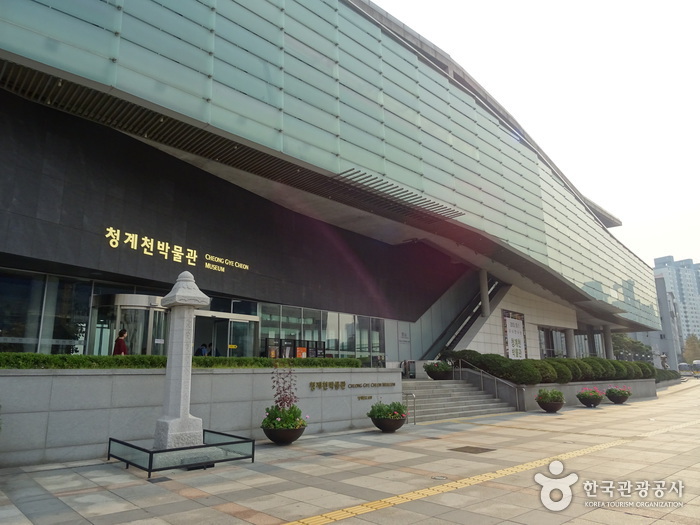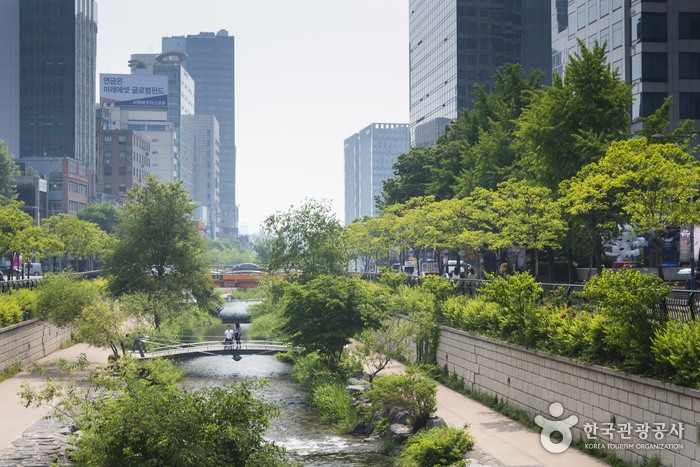Cheonggyecheon Museum (청계천박물관)
2.7Km 2021-11-02
530, Cheonggyecheon-ro, Seongdong-gu, Seoul
+82-2-2286-3410
Cheonggyecheon Museum officially opened in October 2005. The museum’s long, glass exterior represents the flowing waters of Cheonggyecheon Stream, which runs through the heart of Seoul. The museum has a permanent exhibition hall, special exhibition hall, educational hall, and an auditorium. The museum contains visual representations of Seoul before and after the transition of Cheonggyecheon Stream. The permanent exhibition hall was remodeled in October 2015, and now offers even more ways to view the history of Seoul as shaped by Cheonggyecheon Stream.
Cheonggyecheon Stream (청계천)
2.7Km 2024-05-16
Changsin-dong, Jongno-gu, Seoul
+82-2-2290-7111
Cheonggye Plaza was built on Sejong-ro Street, where Cheonggyecheon Stream begins. It was built between Dong-A Ilbo, the starting point of the Cheonggyecheon Stream restoration, and Sindap Railroad Bridge, with a length of 160 meters, a x_width of 50 meters, and a total area of 6,962 meters squared. The plaza is decorated with fountains, waterfalls, and walking paths. It was created as a place for meetings, harmony, peace, and unification, to celebrate the significance of the restoration of Cheonggyecheon Stream. A miniaturized version of Cheonggyecheon Stream is displayed here, providing an overview of the restored stream. There are also interpretive panels about the 22 bridges that cross Cheonggyecheon stream. Fountains of various shapes create beautiful scenery. Cheonggyecheon Stream is accessible from the square through stairs on the left and Cheonggye Trail on the right. There is also an 18-meter tunnel on the Cheonggye Trail, providing a unique experience for citizens entering Cheonggyecheon Stream from the plaza. After constructing Cheonggyecheon Plaza, the Seoul Metropolitan Government made it a car-free street on public holidays so that the plaza, waterside area, and streets could be used as cultural spaces for citizens to relax. A spectacular sight is created by three-color lights illuminating the fountains and a two-tiered waterfall coming down from a x_height of four meters. Palseokdam, made of eight stones from eight provinces in Korea, was laid along the waterfall's sides.
Soda - Hyundai Dongdaemun Branch [Tax Refund Shop] (소다 현대동대문점)
2.7Km 2024-04-22
3F, 20, Jangchungdan-ro 13-gil, Jung-gu, Seoul
-
KL - Hyundai Outlets Dongdaemun Branch [Tax Refund Shop] (KL 현대아울렛동대문점)
2.7Km 2024-04-16
3F Hyundai City Outlet Dongdaemun Branch, 20, Jangchungdan-ro 13-gil, Jung-gu, Seoul
-
Zio Songzio - Hyundai Dongdaemun Branch [Tax Refund Shop] (지오송지오 현대동대문)
2.7Km 2024-04-22
6F, 20, Jangchungdan-ro 13-gil, Jung-gu, Seoul
-
The Handsome Mine - Hyundai Dongdaemun Branch [Tax Refund Shop] (한섬 마인 현대동대문)
2.7Km 2024-04-17
Hyundai City Outlet Dongdaemun Branch, 20, Jangchungdan-ro 13-gil, Jung-gu, Seoul
-
Demoo - Hyundai Dongdaemun Branch [Tax Refund Shop] (데무 현대동대문)
2.7Km 2024-04-17
3F, 20, Jangchungdan-ro 13-gil, Jung-gu, Seoul
-
Daehyun Zooc - Hyundai Dongdaemun Branch [Tax Refund Shop] (대현 쥬크 현대동대문)
2.7Km 2024-04-17
Hyundai City Outlet Dongdaemun Branch, 20, Jangchungdan-ro 13-gil, Jung-gu, Seoul
-
Olens - Hyundai Dongdaemun Branch [Tax Refund Shop] (오렌즈 현대동대문)
2.7Km 2024-04-22
B1 (Hyundai City Outlet Dongdaemun Branch, Eulji-ro 6-ga), 20, Jangchungdan-ro 13-gil, Jung-gu, Seoul
-
Trugen - Hyundai Dongdaemun Branch [Tax Refund Shop] (트루젠 현대동대문)
2.7Km 2024-04-18
20, Jangchungdan-ro 13-gil, Jung-gu, Seoul
-


![Soda - Hyundai Dongdaemun Branch [Tax Refund Shop] (소다 현대동대문점)](http://tong.visitkorea.or.kr/cms/resource/96/2887796_image2_1.jpg)
![KL - Hyundai Outlets Dongdaemun Branch [Tax Refund Shop] (KL 현대아울렛동대문점)](http://tong.visitkorea.or.kr/cms/resource/06/2887806_image2_1.jpg)
![Zio Songzio - Hyundai Dongdaemun Branch [Tax Refund Shop] (지오송지오 현대동대문)](http://tong.visitkorea.or.kr/cms/resource/26/2888926_image2_1.jpg)
![The Handsome Mine - Hyundai Dongdaemun Branch [Tax Refund Shop] (한섬 마인 현대동대문)](http://tong.visitkorea.or.kr/cms/resource/55/2888055_image2_1.jpg)
![Demoo - Hyundai Dongdaemun Branch [Tax Refund Shop] (데무 현대동대문)](http://tong.visitkorea.or.kr/cms/resource/75/2888075_image2_1.jpg)
![Daehyun Zooc - Hyundai Dongdaemun Branch [Tax Refund Shop] (대현 쥬크 현대동대문)](http://tong.visitkorea.or.kr/cms/resource/95/2888095_image2_1.jpg)
![Olens - Hyundai Dongdaemun Branch [Tax Refund Shop] (오렌즈 현대동대문)](http://tong.visitkorea.or.kr/cms/resource/31/2889131_image2_1.jpg)
![Trugen - Hyundai Dongdaemun Branch [Tax Refund Shop] (트루젠 현대동대문)](http://tong.visitkorea.or.kr/cms/resource/48/2889148_image2_1.jpg)
 English
English
 한국어
한국어 日本語
日本語 中文(简体)
中文(简体) Deutsch
Deutsch Français
Français Español
Español Русский
Русский